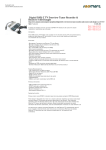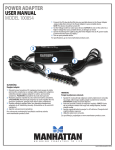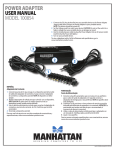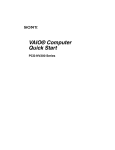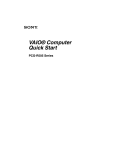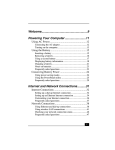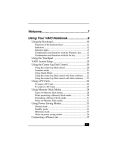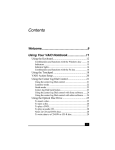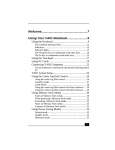Download Sony PCG-GRX650 Quick Start Manual
Transcript
VAIO® Notebook Quick Start PCG-GRX520 Series PCG-GRX560 Series PCG-GRX580 Series PCG-GRX650 Series Welcome.......................................................5 Unpacking Your Notebook .........................................7 Registering Your Notebook ........................................9 About Adding Memory ...............................................9 Setting Up Your Dial-Up Connection .......................10 Setting Up Your VAIO® Notebook ...........15 Locating Controls and Ports ......................................16 Connecting a Power Source ......................................21 Starting Your Notebook ............................................27 Shutting Down Your Notebook.................................28 Software and Support Information ..........31 Software Overview....................................................32 Software Support Information...................................34 Using the Recovery CDs...........................37 Application, Driver, and System Recovery CDs.......38 Using Your Recovery CDs........................................39 Troubleshooting ........................................45 Getting Help ...............................................51 Support Options.........................................................51 Index ...........................................................53 3 VAIO® Computer Quick Start 4 Welcome Congratulations on your purchase of the Sony VAIO® notebook. Sony has combined leading-edge technology in audio, video, computing, and communications to provide you with state-of-the-art personal computing. Features ✍ For a complete description of the specifications of your VAIO® notebook, see the Specifications flyer supplied with your notebook. ❑ Exceptional performance — Your notebook includes a Mobile Intel® Pentium® 4 processor-M that supports Enhanced Intel® SpeedStep™ technology* and a V.90 compatible modem.† To combine performance and portability, Sony has implemented speed-controlling technology designed to maximize battery life during mobile computer use. Windows® reported actual CPU speed may not reflect the maximum CPU speed.‡ ❑ Portability — Rechargeable battery pack provides hours of use without AC power. ❑ Sony audio and video quality — High-quality MPEG1/MPEG2 video, which supports full-screen display and enables you to take advantage of today’s advanced multimedia applications, games, and entertainment software. ❑ Multimedia features — Enjoy the stereo speakers or use a pair of headphones (not supplied) to listen to audio CDs and DVDs. ❑ Microsoft® Windows® operating system — Your system includes Microsoft® Windows® XP Professional, Microsoft® Windows® XP Home Edition, or Microsoft® Windows® 2000 Professional. * The processor may be reduced to a lower operating speed under certain conditions. † Actual upload and download speeds may vary due to line conditions, ISP support, and government regulations. ‡ Depending on the specific model you purchased, speed-controlling technology may not be present. 5 VAIO® Computer Quick Start ❑ Communications — Access popular online services, send e-mail, browse the Internet, and use fax features. ❑ Optical drive (CD-RW/DVD Combo) — Your system includes a CDRW/DVD Combo Drivee. The CD-RW/DVD Combo Drive utilizes a new optical storage technology that combines the features of both a CD-RW drive and DVD-ROM drive, providing increased storage capacity and a rich multimedia computing experience. Optical drives play most DVD-ROM, DVD-R, CD-ROM, CD-RW, and CD-R discs. This drive is hot-swappable. ✍ Your computer’s optical disc drive and other parts may differ depending on the model you purchased. 6 Unpacking Your Notebook Unpacking Your Notebook Remove the following hardware items from the box: Main unit* Power cord AC adapter Rechargeable battery pack Weight saver * The removable optical disc drive is preinstalled in your notebook. Documents ❑ VAIO® Notebook User Guide — A searchable online help file that contains detailed information on how to use your new notebook. (Windows XP) Press Start on the Windows® taskbar, select VAIO Help and Support, and click VAIO User Guide to open this file. (Windows 2000) Press Start, select VAIO Help Center, and VAIO Documentation. ❑ VAIO® Notebook Quick Start — Contains information on unpacking and setting up your notebook, supplementary updates, and software information. ❑ Microsoft® Windows® manual — Explains how to use the basic features of this latest Windows operating system. ❑ VAIO® Notebook Safety Information — Explains notes on use and offers safety tips. 7 VAIO® Computer Quick Start VAIO® Notebook Specifications — Details the hardware specifications for your notebook. Depending on the specific model you purchased, the Specifications are either printed or an electronic file accessible via the User Guide. ❑ Software CDs Microsoft® Word — Enables you to reinstall Microsoft Word to the VAIO® notebook you purchased. ❑ Recovery CDs ❑ Application Recovery CD(s) — Enables you to reinstall individual applications if they become corrupted or are erased. ❑ Driver Recovery CD(s) — Enables you to reinstall individual device drivers if they become corrupted or are erased. ❑ System Recovery CD(s) — Enables you to restore the operating system and software that shipped with your computer if they become corrupted or are erased. Other ❑ Packet containing special product offers ❑ Warranty Card 8 Registering Your Notebook Registering Your Notebook Take advantage of Sony’s commitment to quality customer support and receive these benefits by registering your notebook: ❑ Sony Customer Support — Talk to a Support Representative to troubleshoot problems you may be having with your notebook. ❑ Limited Warranty — Protect your investment. See the Warranty Card for more details. ✍ You are prompted to register your computer the first time you turn on the unit. Follow the on-screen instructions to complete the registration process. If you are not able to register your computer during the first session, you are provided with additional registration opportunities later. Accessing the User Guide The online VAIO® Computer User Guide is a searchable online help file that contains detailed information on how to use your new computer. (Windows XP) To open this file, click Start on the Windows® taskbar, select Help and Support, and click VAIO User Guide. (Windows 2000) Click Start on the Windows® taskbar, select VAIO Help Center, and VAIO Documentation. About Adding Memory Depending on the configuration you purchased, your computer may accept additional memory modules. For information about installation procedures, refer to the online User Guide and print those relevant steps. The supplied Specifications flyer lists the amount of memory installed, and required memory modules for upgrades. 9 VAIO® Computer Quick Start Setting Up Your Dial-Up Connection This section describes the basic steps for setting up your dial-up connection for the first time. The Connection Wizard guides you through the process of connecting to the Internet and then choosing an Internet Service Provider (ISP) or setting up an existing account. Setting up your dial-up connection (Windows® XP Home Edition/Windows® XP Professional) 1 Click Start from the Windows taskbar and select All Programs. 2 Point to Accessories, Communications, and then click New Connection Wizard. The Location Information window appears. Location Information window 3 10 Follow the instructions on-screen and then click OK to continue. The Phone and Modem Options window appears. Setting Up Your Dial-Up Connection Phone and Modem Options window 4 Select the location from where you are dialing and then click OK. The New Connection Wizard appears. 11 VAIO® Computer Quick Start New Connection Wizard 5 12 Follow the on-screen instructions to finish setting up your dial-up connection. Setting Up Your Dial-Up Connection (Windows® 2000 Professional) 1 Double-click the Connect to the Internet icon on the Windows desktop. The Internet Connection Wizard appears. Internet Connection Wizard 2 Follow the on-screen instructions to finish setting up your dial-up connection and to choose your ISP. 13 VAIO® Computer Quick Start 14 Setting Up Your VAIO® Notebook This section describes all the controls and ports on your notebook, how to connect your notebook to a power source, and how to start and shut down your notebook. ❑ Locating Controls and Ports ❑ Connecting a Power Source ❑ Starting Your Notebook ❑ Shutting Down Your Notebook 15 VAIO® Computer Quick Start Locating Controls and Ports Front 4 1 8 Hard disk drive indicator 2 Memory Stick® media indicator Num Lock indicator 9 3 4 5 6 7 Caps Lock indicator Scroll Lock indicator Power indicator Battery 1 indicator Battery 2 indicator 10 11 12 13 14 LCD (Liquid Crystal Display) screen Keyboard Speakers Left and right buttons Touchpad Power button 16 Locating Controls and Ports Left 1 2 3 4 5 PC Card slots Back button for center Jog Dial™ control Center Jog Dial™ control CD-RW/DVD Combo Drive drive in multipurpose bay* Eject button 6 7 Manual eject button Memory Stick® media slot 8 9 USB port i.LINK® (IEEE 1394) S400 port * This multipurpose bay can house either an optical disc drive or an optional second battery. 17 VAIO® Computer Quick Start Right 1 2 3 4 5 Drive bay with hard disk drive Battery bay Headphone jack Microphone jack* USB port * There is a protruding dot above the Microphone jack to further distinguish it from other jacks and ports. Do not connect a microphone to the Headphone jack. 18 Locating Controls and Ports Back 1 2 3 4 Air vent DC In port Ethernet port VGA port 5 6 7 8 Printer port USB port AV Out jack Phone line jack Only connect 10BASE-T and 100BASE-TX cables to the Ethernet port. Do not connect any other type of network cable or any telephone line. Connecting cables other than those listed above may result in an electric current overload and could cause a malfunction, excessive heat, or fire in the port. To connect the unit to the network, contact your network administrator. ✍ There is a ventilation slot located on the left side of the back panel. Do not cover the ventilation slot when your notebook is on. 19 VAIO® Computer Quick Start Bottom 1 2 3 4 20 Tilt stands Multipurpose bay RELEASE lever Reset button Port replicator connector Connecting a Power Source Connecting a Power Source You can use either AC power or a rechargeable battery pack as a power source. Using the AC adapter 1 Plug the cable attached to the AC adapter into the DC In port on the notebook. 2 Plug one end of the power cord into the AC adapter. 3 Plug the other end of the power cord into an AC outlet. Connecting the AC adapter Notebook AC adapter (supplied) Power cord (supplied) To DC In Notes on the AC adapter ❑ Your notebook operates on 100V-240V AC 50/60 Hz. ❑ Do not share the AC outlet with other power-consuming equipment, such as a copy machine or shredder. ❑ You can purchase a power strip with a surge protector. This device prevents damage to your notebook caused by sudden power surges such as those that may occur during an electrical storm. ❑ Do not place heavy objects on the power cord. ❑ To disconnect the cord, pull it out by the plug. Never pull the cord itself. 21 VAIO® Computer Quick Start ❑ Unplug your notebook from the wall outlet if you will not be using the notebook for a long time. ❑ The LED indicator on the AC adapter may be turned on until the AC adapter is unplugged from your notebook. ❑ When the AC adapter is not used, unplug it from the AC outlet. ❑ Use only the AC adapter supplied. Do not use any other AC adapter. Using battery power You can use one or two battery packs as a source of power. The second battery pack inserts into the multipurpose bay on the left side of the notebook. (See “Using a Second Battery Pack” in the online User Guide for more information.) Additional battery packs are available as a separate option. The battery pack that comes with your notebook is not fully charged at the time of purchase. Follow the steps below to insert and charge the battery pack. To insert the battery pack 1 Push the battery bay cover down to open it. ✍ The battery bay cover swings out but does not detach. Battery bay 2 22 Insert the battery pack into the battery bay on the right side of the notebook. Connecting a Power Source Inserting battery pack Battery pack (supplied) VAIO logo facing up 3 Lift the battery bay cover up until it clicks. ✍ If the port replicator is attached to your notebook, do not attempt to insert or remove the battery pack. Lifting and turning the notebook with a port replicator attached could cause a temporary loss of power. To charge the battery pack 1 Connect the AC adapter to the notebook. 2 Insert the battery pack. The notebook automatically charges the battery. The battery indicator flashes in a double-blink pattern as the battery charges. 3 When the battery is 85 percent full, the battery indicator turns off. This process takes several hours when your notebook is using AC power. ✍ To charge the battery completely, continue charging for an additional hour. See “Displaying Battery Information” in the online User Guide for more information. There are two battery indicators on the notebook 23 VAIO® Computer Quick Start Battery indicators Battery indicators Battery Indicator 1 2 Battery Indicator Light Status On Single blink Double blink Off Description Indicates the status of the battery pack in the battery bay on the right side of the notebook. Indicates the status of the battery pack in the multipurpose bay on the left side of the notebook. Description The notebook is using battery power. The battery is running out of power. The battery is charging. The notebook is using AC power. To remove the battery pack 1 Push the battery bay cover down to open it. 2 Pull out the battery pack. 24 Connecting a Power Source Removing the battery pack 3 Push in and lift up the battery bay cover until it clicks. You will lose data if you remove the battery pack while the notebook is on and not connected to the AC adapter, or if you remove the battery while the notebook is in a power saving mode. Notes on the battery ❑ To determine the remaining battery charge, see “Displaying Battery Information” in the online User Guide for more information. ❑ When the battery power is running low, both the battery and power indicators blink. ❑ When the notebook is directly connected to AC power and has a battery pack in the battery bay, it uses power from the AC outlet. ❑ See “Using a Second Battery Pack” in the online User Guide for information on installing and charging a battery pack in the multipurpose bay. ❑ Keep the battery pack in the notebook while it is directly connected to AC power. The battery pack continues to charge while you are using the notebook. ❑ If the battery level falls below 10 percent, you should either attach the AC adapter to recharge the battery, or shut down your notebook and insert a fully charged battery. ❑ You can extend battery life by changing the power management modes in the PowerPanel™ utility. See “Using Power Saving Modes” in the online User Guide for more information. 25 VAIO® Computer Quick Start ❑ The battery pack supplied with your notebook is a lithium-ion battery and can be recharged at any time. Charging a partially discharged battery does not affect battery life. ❑ For some software applications and some peripheral devices, your notebook may not enter Hibernate mode when the battery life is low. To avoid loss of data when using battery power, you should save your data frequently and manually activate a power management mode, such as Standby or Hibernate. ❑ Never leave the battery pack in temperatures above 140° F (60° C), such as under direct sunlight or in a car parked in the sun. ❑ Battery life is shorter in a cold environment. This is due to decreased battery efficiency at low temperatures. ❑ Charge the batteries at temperatures between 50° F and 80° F (10° C to 30° C). Lower temperatures require a longer charging time. ❑ While the battery is in use or being discharged, the battery pack heats up. This is normal and is not cause for concern. ❑ Keep the battery pack away from all sources of heat. ❑ Keep the battery pack dry. ❑ Do not open or try to disassemble the battery pack. ❑ Do not expose the battery pack to any mechanical shock. ❑ If you are not using the notebook for an extended period of time, remove the battery pack from the notebook to prevent damage to the battery. ❑ If, after fully charging the battery pack, the battery power is still low, the battery pack may be reaching the end of its life and should be replaced. ❑ If you have not used the battery pack for a considerable amount of time, recharge the battery. 26 Starting Your Notebook Starting Your Notebook 1 Slide the LCD lock lever in the direction of the arrow, and lift the cover. Opening the notebook LCD lock lever 2 Press the power button on top of the notebook until the green power indicator turns on. Power button Power button Power indicator ✍ If you hold the power button down for more than four seconds, the notebook turns off. 3 If necessary, adjust the brightness controls for the LCD display as follows: ❑ To increase brightness, press Fn+F5 then the up or right arrow key. ❑ To decrease brightness, press Fn+F5 then the down or left arrow key. 27 VAIO® Computer Quick Start Shutting Down Your Notebook To avoid potential loss of data, follow these steps to shut down your notebook. (For Windows® 2000 Professional) 1 Click the Start button on the Windows® taskbar. 2 Click Shut Down at the bottom of the Start menu to display the Shut Down Windows dialog box. 3 Select Shut Down. 4 Click OK. ✍ Respond to any prompts warning you to save documents. 5 Wait for your notebook to turn off automatically. The notebook is off when the power indicator turns off. 6 Turn off any peripherals connected to your notebook. ✍ During a period of inactivity, you can conserve battery life by using Standby mode. See “Controlling Power Management” in the online User Guide for more information. (For Windows® XP) 1 Click Start on the Windows taskbar. 2 Click Turn Off Computer at the bottom of the Start menu to display the “Turn off computer” dialog box. 3 Select Turn Off. ✍ Respond to any prompts warning you to save documents. 4 Wait for your notebook to turn off automatically. The notebook is off when the power indicator turns off. 5 Turn off any peripherals connected to your notebook. 28 Shutting Down Your Notebook ✍ During a period of inactivity, you can conserve battery life by using Standby mode. See “Controlling Power Management” in the online User Guide for more information. If you are unable to shut down your notebook. 1 2 Close or end all operations as follows: ❑ Close all applications. ❑ Remove the PC Cards. ❑ Disconnect USB devices. (Windows XP) Press the Crtl+Alt+Delete keys simultaneously. The Windows Task Manager screen appears. Click Shut Down, and select Turn Off. (Windows® 2000) Press the Ctrl+Alt+Delete keys simultaneously. The Windows Security screen opens. Click Shut Down, and use the drop-down arrow to select Restart. ✍ If you are still unable to shut down the notebook, press the power button and hold it for more than four seconds. This operation may result in data loss. 29 VAIO® Computer Quick Start 30 Software and Support Information Your VAIO® notebook is ready to help you work, play, learn, and communicate as soon as you turn it on. This section provides the following: ❑ Software Overview ❑ Software Support Information 31 VAIO® Computer Quick Start Software Overview Your computer may not be supplied with all of the software listed below, depending on the configuration you purchased. Preinstalled software may not be identical to retail versions, or include supporting documentation. ❑ Adobe® Acrobat® Reader® — Adobe Systems Inc. ❑ Adobe® Photoshop® Elements* — Adobe Systems Inc. ❑ Adobe® Premiere® LE* — Adobe Systems Inc. ❑ America Online® — America Online, Inc. ❑ ArcSoft PhotoPrinter® 2000 Pro — ArcSoft, Inc. ❑ DigitalPrint — Sony Electronics Inc. ❑ Drag’n Drop CD* — DigiOn, Inc., and Easy Systems Japan Ltd. ❑ DVgate™ — Sony Electronics Inc. ❑ EarthLink Network Total Access® — EarthLink, Inc. ❑ EverQuest* — Sony Online Entertainment Inc. ❑ Microsoft® Office XP Small Business Edition* — Microsoft Corp. ❑ Microsoft® Office XP Professional* — Microsoft Corp. ❑ Microsoft® Word* — Microsoft Corp. ❑ MovieShaker™ — Sony Electronics Inc. ❑ OpenMG™ Jukebox — Sony Electronics Inc. ❑ PC-Cillin® 2000 — Trend Micro, Inc. ❑ PicoPlayer™ — Sony Electronics Inc. ❑ PictureGear™ — Sony Electronics Inc. ❑ Quicken® New User Edition† — Intuit Inc. ❑ QuickTime® — Apple Computer, Inc. ❑ RealJukebox® — RealNetworks, Inc. ❑ RealPlayer® — RealNetworks, Inc. ❑ Smart Capture — Sony Electronics Inc. ❑ Smart Connect* — Sony Electronics Inc. ❑ SonicStage™ — Sony Electronics Inc. * On selected models. † Existing Quicken users may be required to pay upgrade fee. 32 Software Overview ❑ Sony ScreenBlast™ ACID* — Sony Pictures Digital Entertainment ❑ Sony ScreenBlast™ Sound Forge* — Sony Pictures Digital Entertainment ❑ Sony on Yahoo! — Yahoo! Inc. ❑ VAIO® Support Agent — Sony Electronics Inc. ❑ VisualFlow™ — Sony Electronics Inc. ❑ WinDVD® — InterVideo, Inc. 33 VAIO® Computer Quick Start Software Support Information Adobe® Acrobat® Reader®, Photoshop® Elements, Premiere® LE (Adobe Systems Inc.) Web site http://www.adobe.com/ e-mail [email protected] phone 206-675-6126 (fee-based support) fax 206-628-5737 hours M-F, 6 AM-5 PM (PST) America Online® (America Online, Inc.) Web site http://www.aol.com/ phone 800-827-6364 hours 7 days a week, 24 hours a day Arcsoft PhotoPrinter® 2000 Pro (ArcSoft, Inc.) Web site http://www.arcsoft.com e-mail [email protected] phone 510-440-9901 fax 510-440-1270 hours M-F, 8:30 AM-5:30 PM (PST) Drag’n Drop CD (DigiOn, Inc., and Easy Systems Japan Ltd.) Web site http://www.easy.co.jp/dde/sony/tosupportne.html EarthLink Network Total Access® (EarthLink, Inc.) Web site http://support.earthlink.net/ e-mail [email protected] phone 800-890-5128 or 800-890-6356 hours 7 days a week, 24 hours a day 34 Software Support Information PC-Cillin® 2000 (Trend Micro, Inc.) Web site http://www.antivirus.com/pc-cillin/support/ phone 510-859-0308; 900-820-8324* hours M-F, 8 AM-5 PM (PST) * Support from 510-859-0308 is free of charge, but subject to delays. Support from 900-820-8324 is fee-based, but offers immediate response. Quicken® (Intuit Inc.) Web site http://www.intuit.com/support phone 900-555-4932; 800-644-3193* hours M-F, 5 AM-5 PM (PST) * Support from 900-555-4932 is fee-based. Support from 800-644-3193 is automated and free of charge. QuickTime® (Apple Computer, Inc.) Web site http://www.apple.com phone 800-275-2273 hours M-F, 6 AM-6 PM (PST) RealJukebox®, RealPlayer® (RealNetworks, Inc.) Web site http://service.real.com/rjoptions.html e-mail http://service.real.com/help/call.html (online email form) Sony Applications (Sony Electronics Inc.) Web site http://www.sony.com/pcsupport phone 888-4-SONY-PC (888-476-6972)* hours 7 days a week, 24 hours a day * Support from 1-888-4-SONY-PC is free of charge for 90 days after the original date of purchase. 35 VAIO® Computer Quick Start Windows® Operating System, Word (Microsoft Corp.) Web site http://www.sony.com/pcsupport phone 888-4SONYPC (888-476-6972)* hours 7 days a week, 24 hours a day * Support from 1-888-4-SONY-PC is free of charge for 90 days after the original date of purchase. WinDVD® (InterVideo, Inc.) Web site http://www.intervideo.com phone 510-651-0888 Sony Service Center For the Sony Service Center nearest you, call 1-888-4-SONY-PC (1-888-476-6972) or find Sony Customer Service on the Web at http://www.sony.com/pcsupport. 36 Using the Recovery CDs This section provides you with details on your Sony Application, Driver, and System Recovery CDs. ❑ Application, Driver, and System Recovery CDs ❑ Using Your Recovery CDs 37 VAIO® Computer Quick Start Application, Driver, and System Recovery CDs Your computer comes with the following Application Recovery, Driver Recovery, and System Recovery CDs. You will need an optical disc drive (supplied with selected models) to use these recovery CDs. If your computer does not come with an optical disc drive, use an external optical disc drive. Application Recovery CD(s) Sony Electronics Inc. This CD enables you to reinstall individual applications and device drivers if they become corrupted or are erased. Driver Recovery CD(s) Sony Electronics Inc. This CD enables you to reinstall individual device drivers if they become corrupted or are erased. System Recovery CD(s) Sony Electronics Inc. This CD enables you to restore the operating system and software that shipped with your computer if they become corrupted or are erased. This CD restores your computer to its original factory settings, so user data and applications installed since you started using your computer will be lost. ✍ For models that come with a docking station, make sure you connect the docking station to the computer before using the recovery CDs. 38 Using Your Recovery CDs Using Your Recovery CDs The following sections describe how to use the Application Recovery and System Recovery utilities. To use the Application Recovery CD(s) The Application Recovery CD utility enables you to reinstall individual software applications, device drivers, and to repair software applications if they become corrupted or are erased. Reinstalling an individual software application or device driver may correct a problem you are experiencing with your computer, peripheral hardware, or software. You may not need to reinstall the entire contents of your hard drive. To reinstall all the software titles that shipped with your computer, use the System Recovery CD(s). See “To use the System Recovery CD(s)” on page 41 for more information. ✍ You must be in Windows® to run the Application Recovery CD utility. Reinstalling software applications with the Application Recovery CD(s) 1 Turn on your computer. If your computer is already on, close all open applications. 2 When the Windows desktop appears, insert Sony Application Recovery CD No. 1 into your computer’s optical disc drive. The Application Recovery utility loads automatically. 3 When the Application Recovery menu appears, select the icon for the application you want to restore, and then follow the on-screen instructions to complete the recovery process. ✍ Your system may include one or more Application Recovery CDs. If you have more than one Application Recovery CD, insert the first CD to run the Application Recovery program. You may be prompted to insert the next CD, depending on the application you wish to restore. Reinstalling device drivers with the Application Recovery CD(s) 1 Turn on your computer. If your computer is already on, close all applications. 2 When the Windows desktop appears, insert Application Recovery CD No. 1 into the optical disc drive. 39 VAIO® Computer Quick Start 3 Click Start in the Windows taskbar and click Control Panel. The Control Panel window appears. 4 Click Performance and Maintenance and click System. The System Properties dialog box appears. 5 From the Hardware tab, click Device Manager. 6 Click to select the unknown device or the device that requires the driver installation. The unknown device(s) is identified by a yellow question mark. 7 From the Action menu, click Uninstall. This removes the device driver from your system. Click OK. Repeat for each device driver as necessary. 8 Restart your computer. Click Start in the Windows taskbar, select Turn Off Computer, and then click Restart. 9 When the desktop appears, Windows automatically reinstalls the device driver(s) from the Application Recovery CD. ✍ Your system includes one or more Application Recovery CDs. Insert Application Recovery CD No. 1, to start the application or driver recovery process. You are prompted to insert the next CD(s), depending on the software application or driver you wish to restore. If you have any questions about using the Application Recovery CD(s), visit http://www.sony.com/pcsupport, or contact Sony Customer Support at 1-888-4SONY-PC. To use the Driver Recovery CD(s) The Driver Recovery CD utility enables you to reinstall individual drivers if they become corrupted or are erased. You can reinstall an individual driver to correct a problem that you are experiencing with your computer, hardware, or software application. VAIO Support Agent, an application repair utility, uses a vault feature on the Driver Recovery CD(s) to repair software applications. ✍ If you need to reinstall all of the software applications that shipped with your computer, use the System Recovery CD. You must be in Windows to run the Driver Recovery CD utility. 40 Using Your Recovery CDs Reinstalling specific drivers with the Driver Recovery CD 1 Turn on your computer. If your computer is already on, close all applications. 2 When the Windows desktop appears, insert the Driver Recovery CD into the optical disc drive. 3 Click Start on the Windows taskbar, and click Control Panel. The Control Panel window appears. 4 Click Performance and Maintenance, then System. The System Properties dialog box appears. 5 From the Hardware tab, click Device Manager. 6 Click to highlight the device for which you wish to reinstall the driver. 7 From the Actions menu, select Properties. The Properties dialog box for that device appears. 8 Click Reinstall Driver. The Hardware Update Wizard appears. 9 Click next. The wizard searches for the correct driver on your Driver Recovery CD. 10 When the recovery process is complete, click Finish. Some drivers require that you restart the computer to complete installation. To use the System Recovery CD(s) The System Recovery CD(s) enables you to format your hard disk drive and restores all original software applications. Your computer is returned to the original factory settings. The System Recovery process removes all software that you may have installed since you started using your computer. Reinstall any applications that were not included with the computer when you purchased it. You can use the System Recovery CD(s) to reinstall the operating system and software titles that shipped with your computer if they become corrupted or are erased. You may not need to reinstall the entire contents of your hard drive. If you experience a problem with your computer, reinstalling an individual device 41 VAIO® Computer Quick Start driver or software title may correct the problem. Use the Application Recovery CD(s) to reinstall individual applications and to reinstall device drivers. See “To use the Application Recovery CD(s)” on page 39 for more information. The System Recovery CD(s) contains a backup copy of all the software originally installed on your hard disk drive. It can be used only to recover the hard disk of the computer you purchased. System Recovery options ❑ System Drive Recovery — All data on Drive C is deleted. The factory default settings and software applications are restored on this drive only. ❑ Change Partition Size — All partitions, custom installations, and changes are removed from the hard disk drive. You can set the partition sizes for both the Drive C and Drive D. The original, preinstalled operating system and software applications are restored. ❑ Recovery to Original Factory Defaults — All data and partitions are removed from the hard disk drive. All original factory settings, operating system, and preinstalled software is restored. The System Recovery utility does not back up your system’s data. If you wish to retain your system data, perform a backup to an external media. Using the System Recovery CD(s) Your system may take a few minutes to load necessary files. A blue screen appears during the downloading process. 1 Insert the Sony System Recovery CD in the optical disc drive. The System Recovery utility starts from the optical disc drive. The first CD must be in the drive when your turn on the computer. 2 Shut down your computer as described in the “Shutting Down Your Notebook” on page 28 of your supplied Quick Start. 3 Wait 30 seconds and turn on your computer. 4 The VAIO System Recovery Utility dialog box appears. Click Next. 5 At the pop-up prompt, select Yes to begin the system recovery process. Follow the on-screen instructions. 42 Using Your Recovery CDs If your computer does not start from the Recovery CD 1 Press the power button and hold it for more than four seconds to turn off the computer. 2 Turn on the computer. When the Sony logo is displayed, press the F2 key. The BIOS setup menu screen appears. 3 Press the arrow keys to select the Exit menu. 4 Press the arrow keys to select “Get Default Values” and then press the Enter key. The message “Load default values for all SETUP items.” appears. 5 Make sure “Yes” is selected, and press the Enter key. 6 Press the arrow keys to select “Save and Exit,” and press the Enter key. The message “Save configuration changes and exit now?” appears. 7 Make sure “Yes” is selected, and press the Enter key. The computer restarts from the Recovery CD. ✍ Your system may include one or more System Recovery CDs. If you have more than one System Recovery CDs, insert the first CD to run the System Recovery program. You are prompted to insert the second CD once the information from the first CD has been installed. The recovery process takes from 30 to 60 minutes to complete. After recovering your system using the System Recovery CD(s), you may be prompted to insert your Application Recovery CD(s) after restarting Windows. Insert the Application Recovery CD to automatically complete recovery of your system. 43 VAIO® Computer Quick Start 44 Troubleshooting This section describes how to solve common problems you may encounter when using your notebook. Many problems have simple solutions, so try these suggestions before you visit the Sony Computing Support Web site at http://www.sony.com/pcsupport. ❑ Troubleshooting Your Notebook ❑ Troubleshooting the LCD Screen ❑ Troubleshooting the Mouse and Touchpad Troubleshooting Your Notebook My notebook does not start. ❑ Check that the notebook is plugged into a power source and that it is turned on. Check that the power indicator on the front panel of the notebook indicates that the power is on. ❑ Check that the battery packs are inserted properly and that they are charged. ❑ Make sure there is no floppy disk in the floppy disk drive. ❑ Confirm that the power cord and all cables are connected firmly. ❑ If you plugged the notebook into a power strip or uninterruptible power supply (UPS), make sure the power strip or UPS is turned on and working. ❑ If you are using an external display, check that it is plugged into a power source and turned on. Check that the brightness and contrast controls are adjusted correctly. See the manual that came with your display for details. ❑ Condensation may cause the notebook to malfunction. If this occurs, do not use the notebook for at least one hour. ❑ Take the battery pack off the notebook, unplug the power cord and plug it in again, then turn on the power. 45 VAIO® Computer Quick Start My notebook starts, but a BIOS error is displayed. When the internal backup battery is low on power, it may not start your system properly. The message “Press <F1> to resume, <F2> to setup” appears at the bottom of the screen. Follow these steps: 1 Press the F2 key. The BIOS Setup menu appears. 2 Set the date (month/day/year). Press Enter. 3 Press to select System Time, then set the time (hour: minute: second). Press Enter. 4 Press to select Exit, then press to select Get Default Values. The message “Load default configuration now?” appears. 5 Select Yes and press Enter. 6 Select Save and Exit, and then press Enter. The message “Save Configuration changes and exit now?” appears. 7 Select Yes, and then press Enter. The notebook restarts. My notebook starts, but the message “Operating system not found” appears and Windows does not start. Make sure there is no floppy disk in the floppy disk drive (non-bootable). ❑ ❑ 46 If a non-bootable floppy disk is in the drive, follow these steps: 1 Turn off the notebook, and then remove the floppy disk. 2 Restart the notebook and confirm that Windows starts properly. If Windows still does not start, follow the steps below to initialize the BIOS: 1 Remove any floppy disk from the floppy disk drive. 2 Turn off the notebook. 3 Remove any peripheral devices connected to the notebook. 4 Turn the notebook back on. 5 Press the F2 key when the Sony logo appears. The BIOS setup menu screen appears. 6 Press the directional arrow keys to select the Exit menu. Troubleshooting 7 Press the arrow keys to select “Get Default Values” and then press Enter. The message “Load default configuration now?” appears. 8 Select Yes, then press Enter. 9 Use the directional arrow keys to select Save and Exit, and then press Enter. The message “Save configuration changes and exit now?” appears. 10 Select Yes, then press Enter. The notebook restarts. If your notebook continues to display the message “Operating system not found,” and Windows does not start, use your supplied System Recovery CD to restore the operating system and software titles shipped with your notebook. See “To use the Driver Recovery CD(s)” on page 40 for more information. The System Recovery CD restores your notebook to its original state, so user data and applications will be lost. My notebook stops responding or does not shut down. It is best to shut down your notebook using the Turn Off Computer /Shut Down command on the Windows® Start menu. Using other methods, including those listed here, may result in loss of unsaved data. ❑ Try restarting the notebook. (Windows XP) On the Windows taskbar, click Start, select Turn Off Computer, and then click Turn Off. (Windows 2000) On the Windows taskbar, click Start, select Shut Down, and click OK. ❑ If your computer does not restart, press the Ctrl+Alt+Delete keys at the same time. (Windows XP) The Windows Task Manager dialog box appears, and you can turn off the computer from the Shut Down menu. (Windows 2000) The Windows Security screen opens, and you can click Shut Down. ❑ If the previous step does not work, press and hold the power button for at least four seconds. This turns off the power. ❑ If your notebook stops responding while playing a CD or DVD, stop the CD/DVD, and restart the notebook by pressing the Ctrl+Alt+Delete keys at the same time. (Windows XP) The Windows Task Manager dialog box appears, and you can turn off the computer from the Shut Down menu. (Windows 2000) The Windows Security screen opens, and you can click Shut Down. 47 VAIO® Computer Quick Start ❑ Unplug the notebook from the AC adapter and remove the battery pack from your notebook. ✍ Pressing the Ctrl+Alt+Delete keys to turn off the computer via Windows Task Manager or the Windows Security screen, or turning off the computer with the power switch may result in data loss in files that are currently open. Troubleshooting the LCD Screen My LCD screen is blank. ❑ Check that the notebook is plugged into a power source and that it is turned on. ❑ Check that the power indicator on the notebook is on. ❑ Check that the battery pack is inserted properly and that it is charged. ❑ The notebook may be in LCD (Video) Standby mode. Press any key to activate the screen. ❑ The display mode may be set to external display mode. Press and hold the Fn key while pressing the F7 key several times. Troubleshooting the Mouse and Touchpad My mouse does not work. ❑ If you are using an external mouse, check that the mouse is plugged into the mouse connector. See “Connecting a PS/2® External Mouse or Keyboard” in the online User Guide for more information. ❑ If you are using an optional Sony USB mouse PCGA-UMS1 series, check that the mouse is plugged into the USB port. ❑ If you are still experiencing problems, use your supplied Driver Recovery CD to reinstall the mouse drivers. See “To use the Driver Recovery CD(s)” on page 40 for more information. My touchpad does not work properly. ❑ You may have disabled the touchpad without connecting a mouse to the notebook. To enable the touchpad: 1 48 Press the Windows key and use the arrow keys to select Programs, and then Sony Notebook Setup. Troubleshooting 2 Select the Touchpad tab using the arrow keys. 3 Select Enable Touchpad, and then press the Enter key. ❑ You must restart the notebook to make the touchpad work again. ❑ If your touchpad is interpreting a single tap as a double-click, you must adjust the button assignments. Follow these steps: 1 Press the Windows key and use the arrow keys to select Control Panel, and then Mouse. 2 Change the button assignments in the Mouse Properties dialog box. (One of the buttons is assigned to the double-click action.) ❑ If you are still experiencing problems, check that another mouse was not installed. ❑ You may need to use your Driver Recovery CD to reinstall the mouse drivers. See “To use the Driver Recovery CD(s)” on page 40 for more information. The pointer does not move while using the Touchpad or Mouse. ❑ The computer should be restarted. Follow these steps: 1 Press the Windows key. 2 Press the “U” key to select Turn Off Computer / Shut Down, and then wait at least four seconds. 3 Press the “R” key to restart your computer. ❑ If you cannot turn off your notebook as described in the step above, press the Ctrl+Alt+Delete keys simultaneously. (Windows XP) The Windows Task Manager dialog box appears, and you can turn off the computer from the Shut Down menu. (Windows 2000) The Windows Security screen opens, and you can select Shut Down.Wait at least four seconds, and then restart the computer. ❑ If you cannot restart your notebook as described in the step above, press and hold the power button for more than four seconds to turn off the notebook. ❑ If the pointer does not move while playing a disc, press the Ctrl+Alt+Delete keys simultaneously to stop playback and restart the notebook. ❑ If you are still experiencing problems, check that another mouse was not installed. 49 VAIO® Computer Quick Start ❑ 50 You may need to use your supplied Driver Recovery CD to reinstall the touchpad or mouse drivers. See “To use the Driver Recovery CD(s)” on page 40 for more information. Getting Help Sony provides you with several support resources to answer questions about your VAIO® computer or the preinstalled software. Refer to these resources in the order they are listed. Support Options If you have questions about your computer or the preinstalled software, refer to the following sources for answers in the sequence listed below. 1 VAIO® Computer User Guide The online VAIO® Computer User Guide and the printed VAIO® Computer Quick Start provide you with information on how to maximize your computer capabilities and solve common problems. 2 Software Manuals and Online Help Files The software preinstalled on your computer may come with an online manual. These manuals are stored on the hard disk drive as online Help files. You can find the Help files from the Help menu under the specific software application. Some software applications may come with a printed manual. 51 VAIO® Computer Quick Start 3 Operating System Online Support Your computer comes preinstalled with Microsoft® Windows®. For operating system support, you can access Microsoft® customer support at: http://support.microsoft.com/directory/. 4 VAIO Support Agent You can find VAIO Support Agent by clicking Start and selecting Help and Support. Using advanced diagnostic technology, Sony’s VAIO Support Agent runs scheduled protections of your applications, network settings, and other important software settings. When your software is protected, you can use VAIO Support Agent to repair software problems by restoring your software to any of the previously protected states. 5 Sony Computing Support This service provides instant access to information on commonly encountered problems. Enter a description of your problem and the Knowledge Database searches for the corresponding solutions online. You can access Sony Computing Support at: http://www.sony.com/pcsupport. 52 Index power source 21 computer features 5 locating controls and ports opening A AC adapter 7, 21 connection 21 notes 21 using 21 AC power 21 Application Recovery CD 27 39 registering 9 shutting down 28 starting 27 unpacking 7 connecting power source 21 controls locating 16 B battery pack notes 25 battery packs 7, 22 charging 23 indicator light status 23 indicator lights 23 inserting 22 inserting into battery bay rechargeable 21 removing 24 using 22 brightness adjusting 27 buttons Start (Windows) 28 16 22 C cables power cord 21 CD-ROM 6, 17 CD-RW 6, 17 charge status indicator light 23 charging battery packs 23 choosing D DC In 21 dial-up connection 10 Driver Recovery CD 40 DVD-R/RW drive 6 E Ethernet port 19 F features 5 G getting help 51 H help 51 I i.LINK 17 indicator lights battery 23 53 VAIO® Computer Quick Start charge status 23 inserting battery pack 22 Internet connection 10 J Jog Dial 17 L M 48 N Notebook features 5 locating controls and ports 16 registering 9 shutting down 28 starting 27 unpacking 7 O optical drive 6 location 17 P ports DC In 21 locating 16 power button 27 cord 21 power source 21 connecting 21 power sources 22 54 rechargeable battery packs 21, recharging battery packs 23 Recovery CDs 39 registering your notebook 9 restoring data 39 S LCD lock lever 27 troubleshooting 48 lever LCD 27 locating controls and ports 16 mouse troubleshooting R 22 second battery pack 22 selecting power source 21 Setting up your dial-up connection 10 Shut Down Windows dialog box 28 shutting down 28 shutting down 28 software support information 34 Software list 31 Sony Service Center 36 starting Notebook 27 startup problems 29 support software 34 System Recovery CD 41 T technical support 51 touchpad troubleshooting 48 troubleshooting 45 LCD 48 mouse and touchpad 48 notebook 45 shutting down 28, 29 startup 29 turning on Notebook 27 U unpacking the computer 7 Index V ventilation slot 19 W Windows Start button 28 taskbar 28, 47 55 http://www.sony.com/vaio Printed in USA © 2002 Sony Electronics Inc. 4-664-802-02


























































